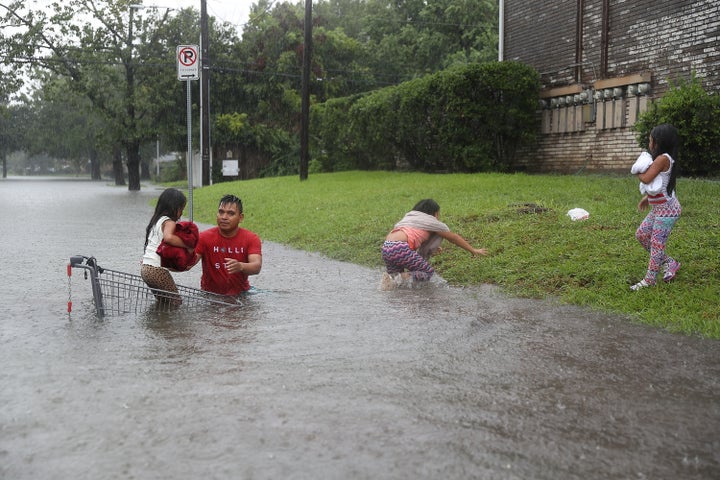
I realized I might have a little weather-triggered PTSD going on when I was awakened at 3 a.m. recently by thunder and howling wind during a fierce storm. I ran immediately to the front door of our little Long Beach, Long Island house and began to panic when I saw water on the floor by the door.
“It’s coming in! The water’s coming in again!” I shouted this to my husband, but it came out in a crazy, shriek-y croak so strange that the dogs all looked at me at once to see what was wrong. I was trying to shout, but it sounded more like a sob.
“Relax, the dogs just came in with wet feet,” he said. “Go back to bed. We’re not flooding. We’re dry.” But even though he sounded calm, the fact is that he, too, was wide awake at 3 a.m., watching the floor by that door to make sure nothing was coming in.
For me, the sight of water on the floor triggered a mental flood—one of bad memories and lessons learned from torrential rains at high tide, from Hurricanes Irene and Sandy, when we had water pouring into our house. Maybe they’re worth sharing at a time when many in Harvey’s path are just starting to deal with the awful aftermath of flooding—and the rest of us need to understand exactly why they’ll need our help long after the waters recede.
Shock and awe accompanies a flood. If you’ve never flooded, the first lesson is that you’re never prepared for how fast the water comes in. You can be sitting on your couch with cats and dogs, listening to the news, reading and waiting for the exact hour and minute of high tide to come and go so you can exhale a very cautious sigh of relief when, in seconds, you’re knee deep in water. The real lesson here is not to kid yourself about riding out a storm, especially if you have kids or pets you need to keep safe. You can’t outrun a flood.
And even the shock of the water pouring in fast can’t prepare you for the next awful fact about floods: Your house may not be filling with filthy storm water, which would be bad enough. You may find instead you’re flooding with sewage.
I imagined trying to dry off and salvage my possessions after the waters receded, but once we got back into the house, we made a really revolting discovery. Lots of our things, books I’d had for decades, baby toys, shoes (including a treasured pair of Frye boots I still miss), family photos and things that truly can never be replaced like the program from my mom’s funeral—everything was covered with sewage. There was no drying it out. Accepting that lots of things can’t be saved may be necessary.
The black mold, dangerous for all humans, but especially for the elderly and little ones and those who are sick or frail with compromised immune systems, blooms immediately as the waters recede. It’s an invasion. Take the threat of mold far more seriously than you do the guys who will show up in your neighborhood with big fans and bleach, telling you they can clean and dry out your house and make it safe. In many cases, they cannot, and you’ll have to rip the walls out anyway when you discover there’s mold behind them. Accepting this now may help you investigate the true extent of the damage and shorten the time it takes you to make your home livable again.
This may be obvious to some, but a sad newsflash to many: Your homeowner’s insurance won’t cover flooding. In many cases it won’t cover wind damage either, unless you have a hurricane rider on your policy. This is the bad news for those who never bought flood insurance—flood-related losses may not be covered. And if you have a flood policy, you can’t necessarily congratulate yourself for being a responsible homeowner, because you may find that you have less access to FEMA disaster relief programs designed for those who didn’t have flood insurance. So, everyone loses.
Big floods often mean that flood insurance companies need to hire a lot of new temporary adjusters fast. And some of the people who get the temporary work are not necessarily contractors—in fact I think one of ours might have worked at Pizza Hut before he showed up at our ruined house after Sandy to assess damage. If you have any doubts about whether your adjuster knows what he or she is doing, make sure you have done a good walk-through of the house, preferably with a contractor, and can point out things a novice might miss.
Even if you have flood insurance, the processing of your claim might be painfully slow. Months after my Sandy adjuster had come and gone, we still had no insurance check to cover damage for little luxuries like the furnace and the water heater, even as the pipes were about to freeze. My advice to those grappling with all this is remember what Donald Trump knows: Twitter is a powerful tool. When my frustration turned to desperation as I waited for our flood insurance check, I tweeted the CEO of our insurance company and had a check via FedEx in two days. You may have to be a squeaky wheel.
Here in Long Beach, one almost never hears anyone refer to the hurricane that hit us just before Halloween in 2012 as “Sandy.” Everyone just calls it The Storm. It may have devastated us, but we never give it the satisfaction of calling it by a name.
Floods are like an iceberg—when you see the water rushing in, you’re only seeing about ten percent of the story. Media reports in a few days will say, “Cleanup has begun” and then drift off to more dramatic news. It’s our job to help those dealing with the awfulness of flooding get back on their feet. Let’s not forget them even after the story moves off the front pages.
